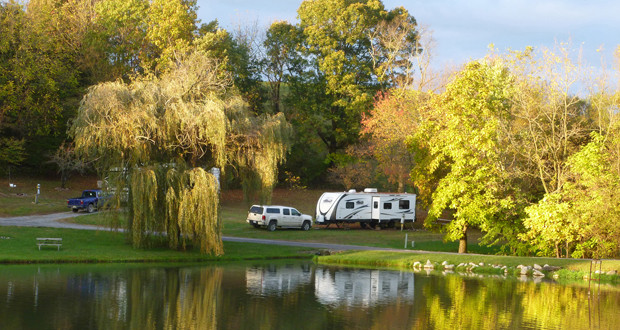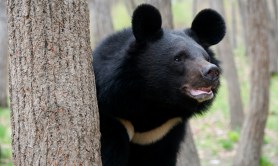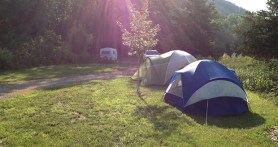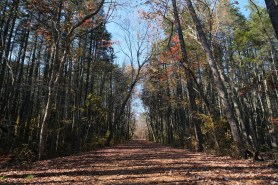

Camp Virginia had the chance to catch up with Andy, who gave us some insights on the best times to visit the campground, how he would spend his time in the campground and the many opportunities for camping at Walnut Hills KOA Campground.
Videos by Outdoors with Bear Grylls
Andy’s Favorite Thing To Do In The Campground
I’d walk. In fact, I have three dogs and I walk them each day, one at a time, which takes me almost an hour because we’re spread out over 43 acres. It’s a great way to see the campground
Andy’s Favorite Campsite
Summer or winter? In the summer I’d probably opt for tent camping on site T-28. In the winter I’d opt for one of our cottages, which come with small kitchens and bathrooms and are delightfully cozy.
Get To Know Walnut Hills KOA Campground
When was Walnut Hills KOA founded? How did it start?
Walnut Hills campground was built 45 years ago, on the site of a former walnut plantation at the headwaters of Christian Creek, in the Shenandoah Valley. It was gradually expanded over the years to its present size of 126 RV sites, 13 cabins and cottages and 11 tent sites, and four years ago became a KOA franchise. The campground remains privately owned, however, and is currently owned and operated by two generations of the Zipser family–with a third generation in the works.

To judge by camper turnout and interest, the high points of our season are the Fourth of July weekend, when we have a super fireworks display; and Halloween weekend, which features a devilishly difficult maze and a spooky haywagon ride, as well as other seasonal activities. But we also have a two-acre fishing pond, a large swimming pool, a game room, playground, horseshoe pits–and, new this year, a completely fenced 9,000-square-foot dog park that has been a big hit with the many campers who travel with pets.
Where is Walnut Hills KOA campground located? What are some other attractions in the area worth checking out?
We’re located in the Shenandoah Valley, about eight miles south of historic Staunton and less than half that distance off I-81, a major north-south artery. That puts us close to Shenandoah National Park and the Blue Ridge Parkway, with their hiking trails and scenic overlooks.
Staunton, meanwhile, is home to one of the largest concentrations of Victorian architecture in any small U.S. city, and in 2012 was ranked 10th on Smithsonian magazine’s list of “20 best small towns in America,” which described it as “a Shenandoah mix of Confederate relics and Elizabethan theater.” The latter reference is to the highly regarded American Shakespeare Center’s Blackfriars Playhouse, but other local attractions include Woodrow Wilson’s birthplace and presidential library, the P. Buckley Moss Museum and the American Museum of Frontier Culture. Slightly farther afield are Grand Caverns (in an area rife with caves), Thomas Jefferson’s home at Monticello and James Monroe’s home at Ash Lawn (both less than 40 miles away) and abundant restaurants, art galleries, wineries and craft brewers.
Which one of the attractions is your favorite?
Asking which one of these is my favorite attraction is like asking a parent which child he favors: much will depend on mood and time of year. But as someone who loves good beer, I’d have to say the Oktoberfests in our area exert a strong pull on me, and as an avid backpacker, I have spent much time on the Appalachian Trail locally (as well as elsewhere).

Our campsites come in a bewildering variety of shapes, sizes and flavors, the result of different sections being built at various times–so much so that we dread internet reservations, because prospective campers often don’t get a clear understanding from KOA’s formulaic online reservation system of what they’re getting; we’d much rather take reservations by telephone. That said, the front section of our campground is designed for large motor coaches and fifth-wheels, with long pull-through sites and no tree cover so as not to impede satellite dishes. The original campground section, along the banks of our two creeks in what remains of the old walnut grove, is best suited for small trailers, pop-ups and tenters who want water and electric. Our lake-side sites have some shade trees and full hookups, and our hill-top section is well-shaded, with additional long pull-through sites and full hook-ups. We also have more heavily wooded primitive tent sites, alongside four rustic cabins that have electricity only.
If you could only spend one hour in the campground, what would you do?
I’d walk. In fact, I have three dogs and I walk them each day, one at a time, which takes me almost an hour because we’re spread out over 43 acres. It’s a great way to see the campground, which is very park-like in appearance and has a remarkable diversity of terrain — creeks, large pond, woods, lawns, hilltop — and a lot of wildlife, including deer, cottontails, snapping turtles, ducks, wild turkeys, hawks, herons, piliated woodpeckers and, yes, a couple of bears. Sometimes.
If you could spend just 1 night in Staunton/Walnut Hills KOA, which campsite would you choose – and why?
Summer or winter? In the summer I’d probably opt for tent camping on site T-28, which is nestled at the far end of the campground between two converging streams and is shaded by huge catalpa trees. This is our most secluded site, and between the shade and the rushing water, the temperature at this site is as much as 10 degrees cooler than in the rest of the park. In the winter I’d opt for one of our cottages, which come with small kitchens and bathrooms and are delightfully cozy.








